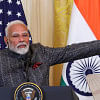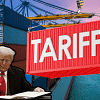Bangladesh at a crossroads: Turning tariff relief into economic triumph?

In a shocking turn of events, the US administration has paused the implementation of its reciprocal tariffs for 90 days. The break follows requests from various governments that have expressed a desire to discuss positive business solutions, foster goodwill, and explore avenues for cooperation. After this initial hiatus, the administration aims to reassess the tariff situation and decide whether to increase or maintain current levels.
In a previous article, it was predicted that a 37 percent tariff on Bangladesh could prove a blessing in disguise if strategically planned. Without such foresight, the country risks losing nearly $3.3 billion by 2029. Now, the critical question is whether Bangladesh will seize this tariff pause as an unprecedented opportunity, face a tough road ahead, or settle for business as usual. By capitalising on this moment—through appointing effective lobbyists in Washington, improving internal conditions, expanding trade relationships, and prioritising diplomatic engagement—Bangladesh can position itself for sustained growth in a dynamic global market.
The tariff situation and the prospects for Bangladesh – what does this mean?
The US has implemented a 10 percent base tariff on all countries, barring China, which faces a significant 145 percent tariff. Of course, China and the USA may decide to sit and sort out their differences at some point, but right now, this shift creates rather favourable prospects for nations such as Bangladesh, as it possibly opens up a share of the market previously dominated by China.
We must note that, no matter what, China is getting expensive and shifting industries within the country, so ultimately, a portion of Chinese business will move out. China's turbulent relationship with the USA may exacerbate the situation further. With Bangladesh currently exporting approximately $16 billion worth of ready-made garments (RMG) to the US, the stricter tariffs on Chinese goods will likely redirect business towards countries that can efficiently meet US demand at lower, more competitive prices.
The OTEXA data from 2018–2024 clearly shows how the trade war affects not just the USA and China, but also other countries quite significantly. Since 2018, China's market share has taken a nosedive by 39.69 percent, while overall US imports have decreased by 4.37 percent. Bangladesh has gained ground with a 35.95 percent growth, Vietnam and India have seen a 22.60 percent increase, and Cambodia and Pakistan have gained 57.86 percent and 58.62 percent respectively. These developments emphasise how fluid the landscape of global trade is and how the competitiveness of different countries in the apparel industry continues to evolve.
Bangladesh is the second-largest supplier of RMG to the USA, trailing China. The country now has a gleaming opportunity to capture a larger market share, provided its RMG sector is prepared to act proactively.
The growth potential in Bangladesh's RMG sector hinges on direct orders to Bangladeshi manufacturers or through Chinese trading houses, and foreign direct investment (FDI) from Chinese firms looking to establish operations in Bangladesh.
This unexpected situation can also provide Bangladesh with an opportunity to diversify exports beyond traditional cotton wear. With 70 percent of Chinese exports to the US consisting of non-cotton items, Bangladesh can tap into this market by producing a broader range of goods. As the nation expands its capabilities, it should aim to include these non-cotton products in its export portfolio.
Bangladesh currently faces a trade deficit with the US of $6.2 billion, the lowest after Pakistan, which stands at $3 billion. Addressing this gap can be beneficial for Bangladesh's overall business prospects with the USA in the long run. The interim government has already expressed interest in exploring agricultural imports such as cotton, wheat, and soybean from the US, which could work effectively to bridge the trade deficit—something many other countries with higher deficits may struggle to negotiate through similar adjustments. The government may also decide to take proactive measures like securing new deals with Boeing and signing a bilateral defence pact that would help the US with its Indo-Pacific strategy.
Bargaining on equal footing
Effective communication and bargaining with US leadership are what will truly help Bangladesh maximise benefits from the current situation. It is important to ensure that trade negotiations reflect Bangladesh's unique position and needs.
Bangladeshi negotiators should first remember that our country charges much lower tariffs on US imports—maintaining a steady average import duty of only 6.10 percent—than other competitor countries. This includes cotton, which the US exports to us tariff-free as of now. US-produced cotton is not the cheapest, but Bangladesh can provide incentives here to promote cotton imports, which will also significantly lessen the trade gap. At the same time, if the USA can incentivise RMG products made with US cotton, it may be economically viable for both countries to import from each other. Lead time is another factor which can be minimised through bonded warehouses that the government has already planned for.
It cannot be forgotten that, while tariffs are being imposed and paused by the US administration, our orders are a work in progress. In order to think about their present and future prospects, US buyers must be fair when calculating profits for orders now, rather than imposing extra tariff burdens on exporters. Exporters, too, must consider their status and future prospects when negotiating. This will no doubt result in a win-win situation for both parties.
Both countries have much to gain through this partnership, and we must be able to show them this through sound, confident diplomatic exchanges—without panicking and keeping in mind future relationships that may change if and when the USA and China decide to hold talks, or when the US administration changes after four years. Both excessive rigidity and leniency can harm the nation during this period of transition.
Negotiations between Bangladesh and the USA should look back on their trade relationship of 40 years. It must be articulated that, trade deficit notwithstanding, the $7.3 billion worth of RMG exported to the US from this country each year is not something any other country can provide overnight, at such reasonable combinations—at least not in the immediate future. It is, therefore, more advantageous for the USA, monetarily speaking, to import RMG from Bangladesh than even reducing the trade gap.
The way forward for Bangladesh
From the above analysis, it is evident that Bangladesh has promising prospects with the USA in future. However, this article also makes it fairly clear that these prospects may only see the light of day if we can lay out before the superpower all the ways in which both our countries can be synergistic for each other.
The question remains: Does Bangladesh have the resolve and resilience to seize the opportunities presented before it?

 For all latest news, follow The Daily Star's Google News channel.
For all latest news, follow The Daily Star's Google News channel. 







Comments